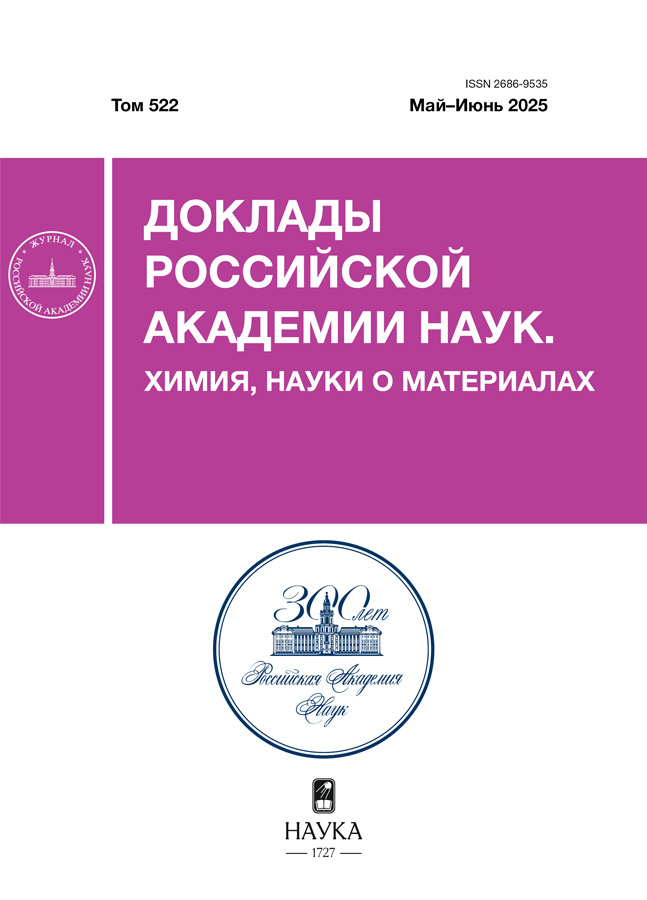Photoinduced Electron Transfer in Reactions of 6-Oxofascaplysine with Biomolecules Studied by the Chemically Induced Dynamic Nuclear Polarization
- Authors: Polyakov N.E.1, Ulyanova M.A.1, Timoshnikov V.A.1, Komarova N.I.2, Krasnov V.I.2, Fomenko V.V.2, Salakhutdinov N.F.2
-
Affiliations:
- Voevodsky Institute of Chemical Kinetics and Combustion of Siberian Branch of Russian Academy of Sciences
- N.N. Vorozhtsov Novosibirsk Institute of Organic Chemistry of Siberian Branch of Russian Academy of Sciences
- Issue: Vol 522, No 1 (2025)
- Pages: 35-41
- Section: PHYSICAL CHEMISTRY
- URL: https://rjmseer.com/2686-9535/article/view/695880
- DOI: https://doi.org/10.31857/S2686953525030055
- ID: 695880
Cite item
Abstract
About the authors
N. E. Polyakov
Voevodsky Institute of Chemical Kinetics and Combustion of Siberian Branch of Russian Academy of Sciences630090 Novosibirsk, Russian Federation
M. A. Ulyanova
Voevodsky Institute of Chemical Kinetics and Combustion of Siberian Branch of Russian Academy of Sciences630090 Novosibirsk, Russian Federation
V. A. Timoshnikov
Voevodsky Institute of Chemical Kinetics and Combustion of Siberian Branch of Russian Academy of Sciences630090 Novosibirsk, Russian Federation
N. I. Komarova
N.N. Vorozhtsov Novosibirsk Institute of Organic Chemistry of Siberian Branch of Russian Academy of Sciences630090 Novosibirsk, Russian Federation
V. I. Krasnov
N.N. Vorozhtsov Novosibirsk Institute of Organic Chemistry of Siberian Branch of Russian Academy of Sciences630090 Novosibirsk, Russian Federation
V. V. Fomenko
N.N. Vorozhtsov Novosibirsk Institute of Organic Chemistry of Siberian Branch of Russian Academy of Sciences
Email: fomenko@nioch.nsc.ru
630090 Novosibirsk, Russian Federation
N. F. Salakhutdinov
N.N. Vorozhtsov Novosibirsk Institute of Organic Chemistry of Siberian Branch of Russian Academy of Sciences630090 Novosibirsk, Russian Federation
References
- Zhidkov M.E., Kantemirov A.V., Koisevnikov A.V., Andin A.N., Kuzmich A.S. // Tetrahedr. Lett. 2018. V. 59. P. 708–711. https://doi.org/10.1016/J.TETLET.2018.01.023
- Luo L., Xu G. // Int. J. Mol. Sci. 2022. V. 23. P. 13774. https://doi.org/10.3390/ijms232213774
- Khokhar S., Feng Y., Campitelli M.R., Ekins M.G., Hooper J.N.A., Beattie K.D., Sadowski M.C., Nelson C.C., Davis R.A. // Bioorg. Med. Chem. Lett. 2014. V. 24. № 15. P. 3329–3332. https://doi.org/10.1016/j.bmcl.2014.05.104
- Wang C., Wang S., Li H., Hou Y., Cao H., Hua H., Li D. // Mar. Drugs. 2023. V. 21. P. 226. https://doi.org/10.3390/md21040226
- Kaptein R. // J. Chem. Soc. D: Chem. Commun. 1971. № 14. P. 732–733. https://doi.org/10.1039/C29710000732
- Salikhov K.M., Molin Yu.N., Sagdeev R.Z.б Buchachenko A.L. Spin polarization and magnetic effects in radical reactions. Molin Yu.N. (ed.). Budapest, Hungary, Academiai Kiadó,1984. 419 p.
- Leshina T.V., Kruppa A.I., Taraban M.B. CIDNP Applications. In: Encyclopedia of spectroscopy and spectrometry. Third Edition. 2017. P. 256–262. http://dx.doi.org/10.1016/B978-0-12-803224-4.00121-7
- Morozova O.B., Ivanov K.L., Kiryutin A.S., Sagdeev R.Z., Köchling T., Vieth H.-M., Yurkovskaya A.V. // Phys. Chem. Chem. Phys. 2011. V. 13. № 14. P. 6619–6627. https://doi.org/10.1039/c0cp02449j
- Morozova O.B., Ivanov K.L. // Chem. Phys. Chem. 2019. V. 20. № 2. P. 197–215. https://doi.org/10.1002/cphc.201800566
- Goez M. Elucidating organic reaction mechanisms using photo-CIDNP spectroscopy. In: Hyperpolarization methods in NMR spectroscopy. Kuhn L.T. (ed.). Berlin, Heidelberg, 2013. P. 1–32. https://doi.org/10.1007/128_2012_348
- Kuhn L.T., Bargon J. Exploiting nuclear spin polarization to investigate free radical reactions via in situ NMR. In: In situ NMR methods in catalysis. Bargon J., Kuhn L.T. (eds.). Berlin, Heidelberg, 2007. P. 125–154. https://doi.org/10.1007/128_2007_119
- Polyakov N.E., Khan V.K., Taraban M.B., Leshina T.V., Luzina O.A., Salakhutdinov N.F., Tolstikov G.A. // Org. Biomol. Chem. 2005. V. 3. P. 881–885. https://doi.org/10.1039/b416133e
- Taraban М.В., Kruppa A.I., Polyakov N.E., Leshina T.V., Lūsis V., Muceniece D., Duburs G. // J. Photochem. Photobiol. A Chem. 1993. V. 73. P. 151–156. https://doi.org/10.1016/1010-6030(93)80044-A
- Mastova A.V., Selyutina O.Yu., Polyakov N.E. // Membranes. 2022. V. 12. P. 460. https://doi.org/10.3390/membranes12050460
- Baram G.I., Grachev M.A., Komarova N.I., Perelroyzen M.P., Bolvanov Y.A., Kuzmin S.V., Kargaltsev V.V., Kuper E.A. // J. Chromatogr. A. 1983. V. 264. № 1. P. 69–90. https://doi.org/10.1016/S0021-9673(01)95007-1
- Hermosilla L., Calle P., García de la Vega J.M., Sieiro C. // J. Phys. Chem. A. 2005. V. 109. № 6. P. 1114–1124. https://doi.org/10.1021/jp0466901
- Weigend F. // Phys. Chem. Chem. Phys. 2006. V. 8. № 9. P. 1057–1065. https://doi.org/10.1039/b515623h
- Neese F., Wennmohs F., Hansen A., Becker U. // Chem. Phys. 2009. V. 356. № 1–3. P. 98–109. https://doi.org/10.1016/j.chemphys.2008.10.036
- Barone V., Cossi M. // J. Phys. Chem. A. 1998. V. 102. № 11. P. 1995–2001. https://doi.org/10.1021/jp9716997
- Oberg C., Buthelezi M.T. Binding of Cu2+ ions to indigo derivatives in aqueous media. 2023. Available at SSRN: http://dx.doi.org/10.2139/ssrn.4455433
- Mao Y., Chen H., Zhu W., Ni S., Luo S., Tang S., Chen Z., Wang Q., Xu J., Tu Q., Chen H., Zhu L. // J. Inflam. Res. 2025. V. 18. P. 883–894. https://doi.org/10.2147/JIR.S498340
Supplementary files










